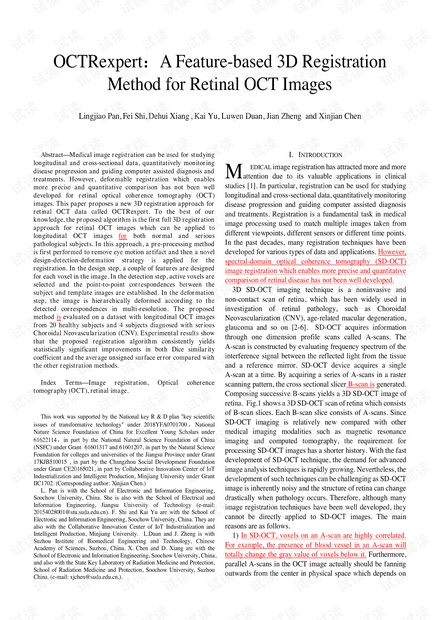
Abstract—Medical image registration can be used for studying
longitudinal and cross-sectional data, quantitatively monitoring
disease progression and guiding computer assisted diagnosis and
treatments. However, deformable registration which enables
more precise and quantitative comparison has not been well
developed for retinal optical coherence tomography (OCT)
images. This paper proposes a new 3D registration approach for
retinal OCT data called OCTRexpert. To the best of our
knowledge, the proposed algorithm is the first full 3D registration
approach for retinal OCT images which can be applied to
longitudinal OCT images for both normal and serious
pathological subjects. In this approach, a pre-processing method
is first performed to remove eye motion artifact and then a novel
design-detection-deformation strategy is applied for the
registration. In the design step, a couple of features are designed
for each voxel in the image. In the detection step, active voxels are
selected and the point-to-point correspondences between the
subject and template images are established. In the deformation
step, the image is hierarchically deformed according to the
detected correspondences in multi-resolution. The proposed
method is evaluated on a dataset with longitudinal OCT images
from 20 healthy subjects and 4 subjects diagnosed with serious
Choroidal Neovascularization (CNV). Experimental results show
that the proposed registration algorithm consistently yields
statistically significant improvements in both Dice similarity
coefficient and the average unsigned surface error compared with
the other registration methods.
Index Terms—Image registration, Optical coherence
tomography (OCT), retinal image.
This work was supported by the National key R & D plan "key scientific
issues of transformative technology" under 2018YFA0701700 , National
Nature Science Foundation of China for Excellent Young Scholars under
61622114,in part by the National Natural Science Foundation of China
(NSFC) under Grant 61601317 and 61601207, in part by the Natural Science
Foundation for colleges and universities of the Jiangsu Province under Grant
17KJB510015 , in part by the Changzhou Social Development Foundation
under Grant CE20165021, in part by Collaborative Innovation Center of IoT
Industrialization and Intelligent Production, Minjiang University under Grant
IIC1702. (Corresponding author: Xinjian Chen.)
L. Pan is with the School of Electronic and Information Engineering,
Soochow University, China. She is also with the School of Electrical and
Information Engineering, Jiangsu University of Technology (e-mail:
20154028001@stu.suda.edu.cn). F. Shi and Kai Yu are with the School of
Electronic and Information Engineering, Soochow University, China. They are
also with the Collaborative Innovation Center of IoT Industrialization and
Intelligent Production, Minjiang University. L.Duan and J. Zheng is with
Suzhou Institute of Biomedical Engineering and Technology, Chinese
Academy of Sciences, Suzhou, China. X. Chen and D. Xiang are with the
School of Electronic and Information Engineering, Soochow University, China,
and also with the State Key Laboratory of Radiation Medicine and Protection,
School of Radiation Medicine and Protection, Soochow University, Suzhou
China. (e-mail: xjchen@suda.edu.cn,).
I. INTRODUCTION
EDICAL image registration has attracted more and more
attention due to its valuable applications in clinical
studies [1]. In particular, registration can be used for studying
longitudinal and cross-sectional data, quantitatively monitoring
disease progression and guiding computer assisted diagnosis
and treatments. Registration is a fundamental task in medical
image processing used to match multiple images taken from
different viewpoints, different sensors or different time points.
In the past decades, many registration techniques have been
developed for various types of data and applications. However,
spectral-domain optical coherence tomography (SD-OCT)
image registration which enables more precise and quantitative
comparison of retinal disease has not been well developed.
3D SD-OCT imaging technique is a noninvasive and
non-contact scan of retina, which has been widely used in
investigation of retinal pathology, such as Choroidal
Neovascularization (CNV), age-related macular degeneration,
glaucoma and so on [2-6]. SD-OCT acquires information
through one dimension profile scans called A-scans. The
A-scan is constructed by evaluating frequency spectrum of the
interference signal between the reflected light from the tissue
and a reference mirror. SD-OCT device acquires a single
A-scan at a time. By acquiring a series of A-scans in a raster
scanning pattern, the cross sectional slicer B-scan is generated.
Composing successive B-scans yields a 3D SD-OCT image of
retina. Fig.1 shows a 3D SD-OCT scan of retina which consists
of B-scan slices. Each B-scan slice consists of A-scans. Since
SD-OCT imaging is relatively new compared with other
medical imaging modalities such as magnetic resonance
imaging and computed tomography, the requirement for
processing SD-OCT images has a shorter history. With the fast
development of SD-OCT technique, the demand for advanced
image analysis techniques is rapidly growing. Nevertheless, the
development of such techniques can be challenging as SD-OCT
image is inherently noisy and the structure of retina can change
drastically when pathology occurs. Therefore, although many
image registration techniques have been well developed, they
cannot be directly applied to SD-OCT images. The main
reasons are as follows.
1) In SD-OCT, voxels on an A-scan are highly correlated.
For example, the presence of blood vessel in an A-scan will
totally change the gray value of voxels below it. Furthermore,
parallel A-scans in the OCT image actually should be fanning
outwards from the center in physical space which depends on
OCTRexpert:A Feature-based 3D Registration
Method for Retinal OCT Images
Lingjiao Pan,
Fei Shi,
Dehui Xiang
, Kai Yu, Luwen Duan, Jian Zheng and Xinjian Chen




 我的内容管理
展开
我的内容管理
展开
 我的资源
快来上传第一个资源
我的资源
快来上传第一个资源
 我的收益 登录查看自己的收益
我的收益 登录查看自己的收益 我的积分
登录查看自己的积分
我的积分
登录查看自己的积分
 我的C币
登录后查看C币余额
我的C币
登录后查看C币余额
 我的收藏
我的收藏  我的下载
我的下载  下载帮助
下载帮助 
 前往需求广场,查看用户热搜
前往需求广场,查看用户热搜

 信息提交成功
信息提交成功